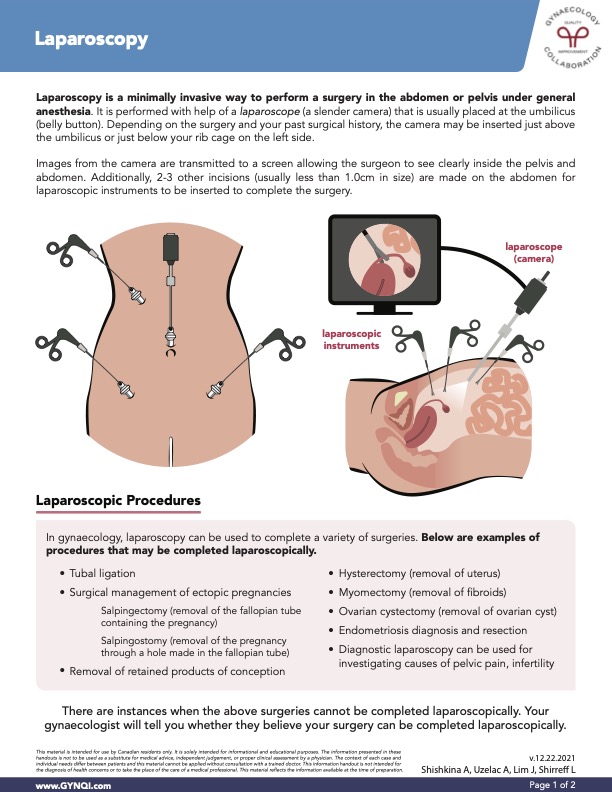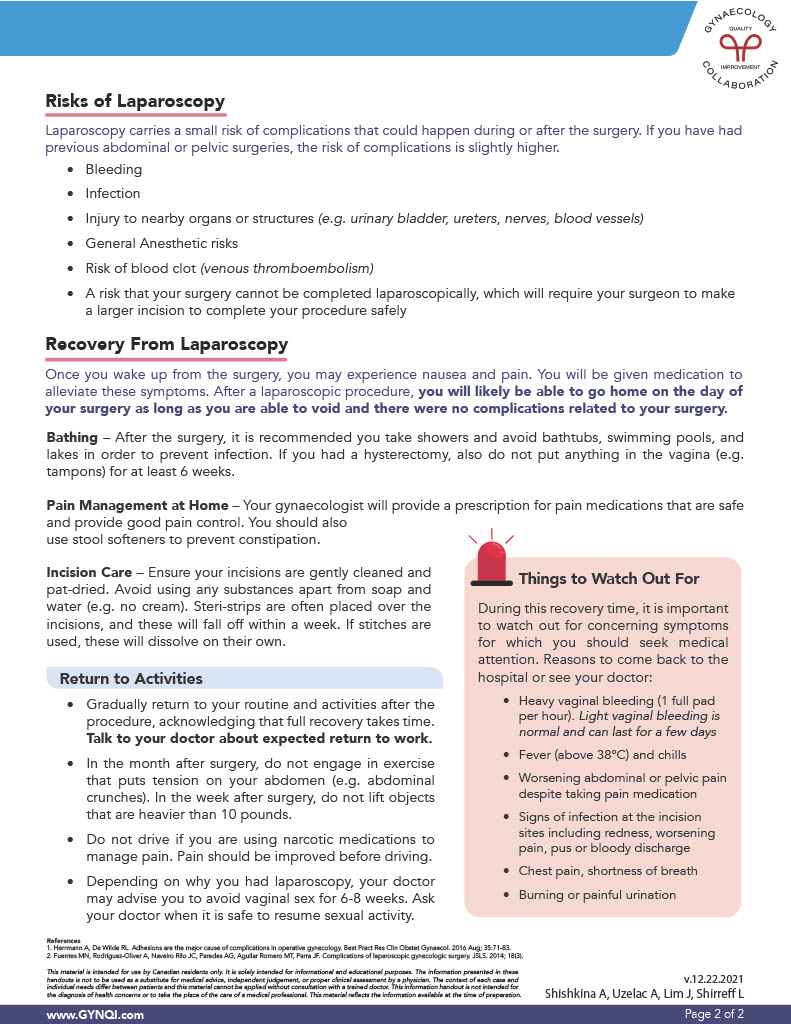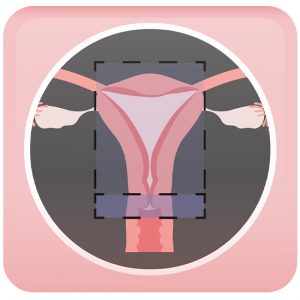

Table of Contents
- Summary
- What is Laparoscopy?
- How Does it Work?
- Laparoscopic Procedures
- Risks of Laparoscopy
- Recovery from Laparoscopy
- Immediate After-care
- Return to Activities
- Things to Watch Out for After Surgery
- Be Informed About Your Surgery Options
Summary:
- Laparoscopy is a surgical method that uses a slender camera inserted through small incisions, providing a clear view of the abdomen and pelvis without the need for larger cuts.
- This technique is frequently utilized for surgeries such as myomectomies, hysterectomies, and the treatment of ectopic pregnancies.
- Patients typically experience faster recovery times, reduced pain, and minimal scarring compared to traditional open surgery.
- While a laparoscopy is generally safe, it carries some risks, including bleeding and infection; proper post-operative care and monitoring for concerning symptoms are crucial for a successful recovery.
A laparoscopy is a minimally invasive surgical technique used to diagnose and treat various conditions within the abdomen and pelvis. This procedure involves the use of a laparoscope—a slender camera inserted through small incisions—allowing surgeons to visualize the internal organs without the need for larger incisions. Laparoscopy is commonly employed in gynaecological surgeries, such as myomectomies and hysterectomies, offering patients benefits like reduced recovery time, less pain, and minimal scarring. Understanding how a laparoscopy works, its potential risks, and the recovery process is essential for anyone considering this innovative approach to surgery.
What is Laparoscopy?
Laparoscopy is a minimally invasive way to perform surgery in the abdomen or pelvis under general anesthesia. It is performed with the help of a laparoscope, a slender camera, that is usually placed at the umbilicus (belly button). Depending on the surgery and your past surgical history, the camera may be inserted just above the umbilicus or just below your rib cage on the left side.
How Does It Work?
Images from the camera are transmitted to a screen, providing the surgeon with a clear view of the pelvis and abdomen. Additionally, two to three other small incisions, typically less than 1cm in size, are made in the abdomen to allow the insertion of laparoscopic instruments for completing the surgery
Laparoscopic Procedures
In gynaecology, laparoscopy can be used to complete a variety of surgeries. Examples of procedures that may be completed laparoscopically include:
- Tubal ligation
- Surgical management of ectopic pregnancies:
- Salpingectomy (removal of the fallopian tube containing the pregnancy)
- Salpingostomy (removal of the pregnancy through a hole made in the fallopian tube)
- Removal of retained products of conception
- Hysterectomy (removal of uterus)
- Myomectomy (removal of fibroids)
- Ovarian cystectomy (removal of ovarian cyst)
- Endometriosis diagnosis and resection
Diagnostic laparoscopy can also be used for investigating causes of pelvic pain and infertility.
There are instances when the above surgeries cannot be completed laparoscopically and your gynaecologist will tell you whether they believe you are a candidate to have you surgery completed laparoscopically or not.
Risks of Laparoscopy
Laparoscopy carries a small risk of complications that could happen during or after the surgery. If you have had previous abdominal or pelvic surgeries, the risk of complications is slightly higher.
Complications can include:
- Bleeding
- Infection
- Injury to nearby organs or structures (e.g. urinary bladder, ureters, nerves, blood vessels)
- General anesthetic risks
- Risk of a blood clot (venous thromboembolism)
- A risk that your surgery cannot be completed laparoscopically, which will require your surgeon to make a larger incision to complete your procedure safely
Recovery from Laparoscopy
Once you wake up from the surgery, you may experience nausea and pain. You will be given medication to alleviate these symptoms.
After a laparoscopic procedure, you will likely be able to go home on the day of your surgery as long as you are able to void and there are no complications related to your surgery.
Immediate After-care
Bathing: After the surgery, it is recommended you take showers and avoid bathtubs, swimming pools, and lakes in order to prevent infection. If you had a hysterectomy, do not put anything in the vagina (e.g. tampons) for at least six weeks.
Pain Management at Home: Your gynaecologist will provide a prescription for pain medications that are safe to use and provide good pain control. You should also use stool softeners to prevent constipation.
Incision Care: Ensure your incisions are gently cleaned and pat-dried. Avoid using any substances apart from soap and water (e.g. no cream). Steri-strips are often placed over the incisions and will fall off within a week. If stitches are used, these will dissolve on their own.
Return to Activities
After surgery, follow the advice of your doctor as to when you can return to your regular activities.
Helpful tips include:
- Gradually ease back into your routine and daily activities after the procedure, keeping in mind that full recovery takes time. Be sure to discuss your expected return to work with your doctor.
- During the first month after surgery, avoid exercises that strain your abdomen, such as abdominal crunches. In the first week, refrain from lifting anything heavier than 10 pounds.
- Avoid driving if you are taking narcotic pain medications, and ensure your pain is well-controlled before getting behind the wheel.
- Depending on the reason for your laparoscopy, your doctor may recommend avoiding vaginal sex for 6-8 weeks. Be sure to ask when it’s safe to resume sexual activity.
Things to Watch Out for After Surgery
During your recovery, it’s important to monitor for any concerning symptoms that may require medical attention.
Reasons to return to the hospital or contact your doctor include:
- Heavy vaginal bleeding (one full pad per hour). Light vaginal bleeding is normal and can last for a few days.
- Fever above 38°C and chills
- Worsening abdominal or pelvic pain despite taking pain medication
- Signs of infection at the incision sites include redness, worsening pain, pus or bloody discharge
- Chest pain and/or shortness of breath
- Burning or painful urination
Be Informed About Your Surgery Options
A laparoscopy is a minimally invasive procedure used in various gynaecological surgeries, offering faster recovery and smaller incisions. Though generally safe, it carries risks such as bleeding, infection, and injury to surrounding organs. Recovery involves managing pain, caring for incisions, and gradually resuming normal activities under your doctor’s guidance. Be mindful of any concerning symptoms, like heavy bleeding or infection, and seek medical attention if needed. Following post-operative instructions ensures a smoother recovery and optimal results.



